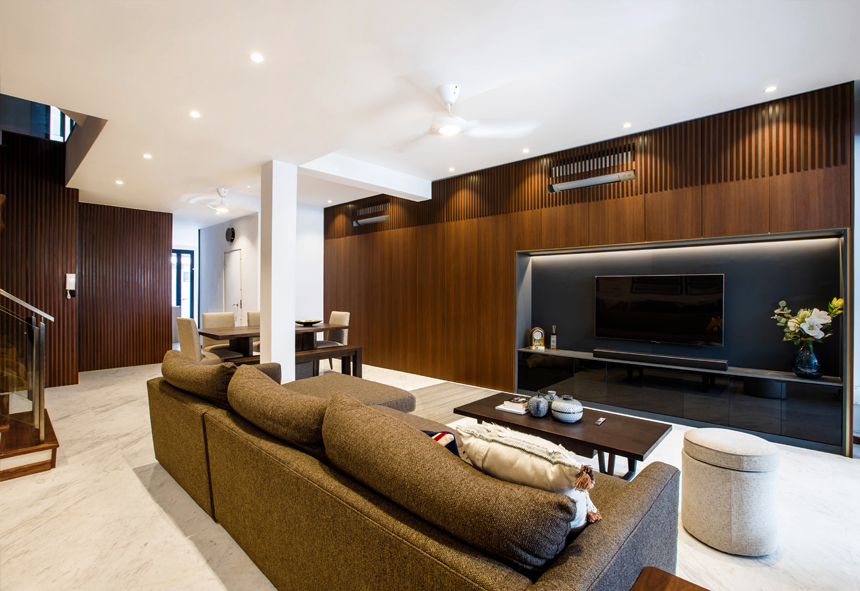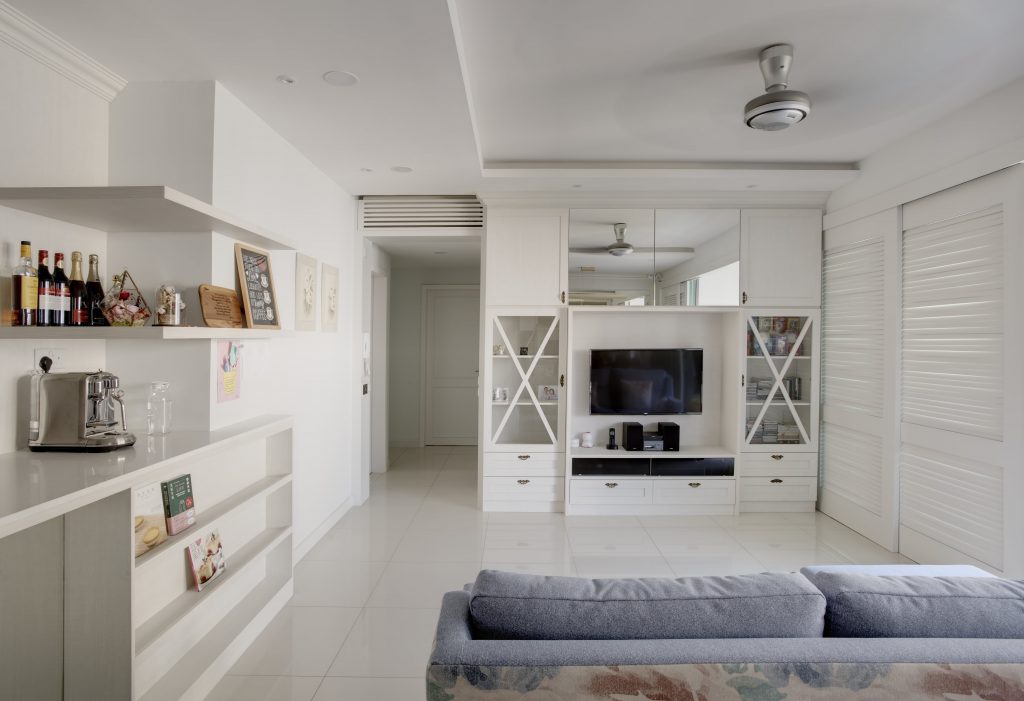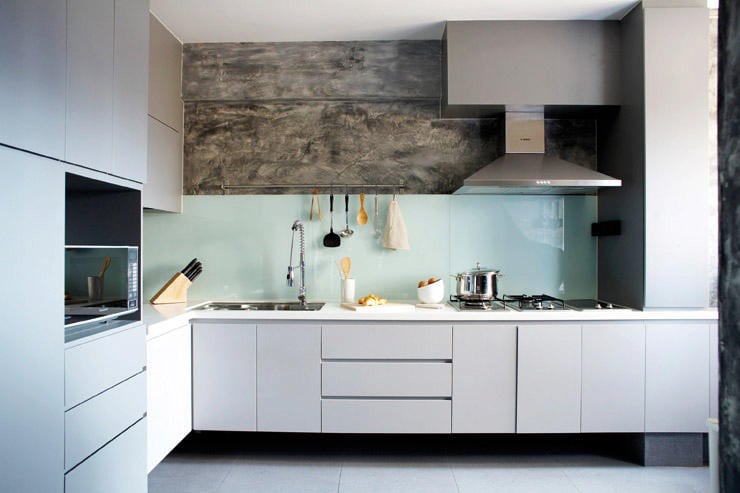Japanese-style minimalism and functionality have been a trending HDB kitchen solution for a few years now. Arguably, the Japanese Muji kitchen design is a style notable for its clean lines, neutral colours and simple design elements. Indeed, Muji is perfect for creating an aesthetically pleasing, minimalist and functional kitchen space in a small kitchen design. Perhaps, you’re already eager to create a Muji kitchen design in your HDB kitchen. In this regard, here are some tips on how to make the most of the space:
What is Muji design?
Muji design is a minimalist, contemporary style of design that focuses on simple forms, materials and colours. It originated in Japan and has become popular worldwide due to its emphasis on minimalism, practicality, and simplicity. The design philosophy of Muji is based on two key principles: ‘simplicity’ and ‘respect for materials’. Simplicity is achieved by avoiding excessive decorations, clutter and unnecessary features. Respect for materials is about using high-quality, natural materials that will last many years.
Muji design has become popular for creating minimalist and functional kitchen designs. Its simple lines, muted colours, and natural materials help create a calm yet modern feel in the kitchen. The use of light wood, metal and glass are key components of this style, as are neutral colours like white, beige, grey and black. These elements combine to create an inviting, stylish, and comfortable space.
A minimalist and functional kitchen design can enhance the overall aesthetic appeal of a home, which is an important aspect of home staging. By creating a clean, clutter-free, and visually appealing kitchen space, potential buyers or renters are more likely to be attracted to the property and envision themselves living in it. Therefore, home staging companies can offer their services to help homeowners design and stage their homes in a way that appeals to a wider audience, including incorporating minimalist and functional kitchen designs like the Japanese Muji style.
What are the basics of Muji kitchen design?
Muji, the Japanese home and lifestyle brand is known for its minimalist aesthetic and practical design. Its minimalism is rooted in the core principle of simplicity: removing any unnecessary clutter or distractions to create a calming and relaxed environment. The Muji kitchen is no exception.
Usually, Muji kitchens are characterised by their clean lines and neutral colour palettes. Moreover, furnishings are lightweight and movable, all in their most basic form. Cabinets are often made of wood, with simple handles and doors. Typically, appliances are stainless steel, with plain surfaces and no excessive detailing. Countertops usually consist of solid surfaces or granite, with none of the ornate edges or decorative details found in traditional kitchens. Overall, Muji kitchen design aims to create an uncluttered space that is incredibly easy to use and maintain.
The image below shows a simple and functional kitchen HDB design by Renozone that incorporates the characteristics of Muji design style such as wood cabinets, clean lines, and simple forms.

How to apply the Muji design principles to your kitchen
When it comes to creating a minimalist and functional HDB kitchen, you can draw a lot of inspiration from Muji’s design philosophy. It’s all about creating a sense of balance, clarity, and simplicity in your kitchen design. Here are some tips for applying Muji-inspired elements to your own kitchen.
- Choose Neutral Colors: One of the key elements of Muji’s design philosophy is the use of neutral colours. This helps create a calming and restful atmosphere in the kitchen. Opt for neutral shades of grey, white, or beige for your kitchen walls and flooring.
- Focus on Functionality: In a Muji kitchen design, functionality is key. In this regard, you should consider maximising space with clever storage solutions and appliances. For example, wall-mounted shelves can make great use of vertical space. At the same time, multipurpose appliances like microwaves with oven grills will save space.
- Think Minimal: To achieve a Muji-style look, strive for minimalism in your kitchen design. Opt for sleek, understated furniture and simple designs with clean lines. Keep countertops free of clutter, and make sure there’s plenty of open space in the kitchen.
- Use Natural Materials: Incorporate natural materials into your kitchen design to give it an organic feel. Choose wood cabinets or counters made from natural stone like marble or granite. Add texture with woven baskets or jute rugs. And don’t forget to bring some greenery into the mix with houseplants or herbs growing in window boxes.
By applying these Muji design principles to your kitchen, you can create a minimalist and functional space that looks beautiful too. With a few simple tweaks, you can have an HDB kitchen that looks modern and stylish without breaking the bank.
Tips for creating a functional and minimalist HDB kitchen
Creating a functional and minimalist kitchen in an HDB apartment can be challenging. However, with the right design elements and thoughtful planning, it is possible to create a sleek and efficient space. Here are some tips to help you nail the ultimate Muji kitchen design:
Choose the Right Materials
When designing a minimalist kitchen, choosing suitable materials is critical. Aim for timeless materials that are both durable and aesthetically pleasing. Natural wood, stone, and concrete are all excellent options for countertops and other surfaces. Finally, select simple hardware finishes, such as brass or matte black, for a classic look.
Arguably, having enough storage is essential for any room, especially a small HDB kitchen. When selecting cabinets and drawers, look for shallow designs that maximise the space in your kitchen. Moreover, adding pull-out pantries and wall shelves can provide extra storage without taking up valuable floor space.
Incorporate Multifunctional Appliances
Opt for multifunctional appliances when possible to keep your kitchen minimalist and clutter-free. An oven with multiple cooking settings, such as convection or steam settings, allows you to cook various dishes without needing multiple bulky appliances. Moreover, consider investing in a compact refrigerator and dishwasher that can fit into tight spaces.
Typically, the key to making any space look bigger is to lighten up. Go for natural light wherever possible, such as installing large windows or skylights. If you’re short on natural light, add recessed lighting and wall fixtures to brighten the area. Use reflective materials such as glass or chrome for countertops and splashbacks to make your kitchen feel more open.
Think Outside the Box
To really stand out, think outside the box with your kitchen design. Incorporating Muji-inspired elements, such as natural wood accents or textured tiles, can give your kitchen a unique aesthetic without looking cluttered. Moreover, you can experiment with different layouts to maximise the kitchen space and make it easier to move around.
Creating a minimalist and functional HDB kitchen doesn’t have to be difficult. With the right design elements and thoughtful planning, you can create a beautiful, stylish, practical space. From selecting timeless materials to optimising storage solutions, these tips can help you create a kitchen you can enjoy for years.
Final Thoughts
To conclude, creating a minimalist and functional HDB kitchen design with Muji elements is an effective way to upgrade your home. By using the basics of Muji kitchen design and applying the principles of this style to your own kitchen, you can create a sleek, modern space that looks good and works for you.
When designing your kitchen, focusing on efficiency and functionality is essential. Ensure you have plenty of storage and areas for prep, cooking and dining. Also, consider natural light and ventilation to make the space feel airier and more inviting.
Creating a minimalist and functional kitchen design can be a great way to streamline your daily routine and create a more peaceful home environment. One popular style for achieving this look is the Japanese Muji kitchen design, which emphasizes simplicity, natural materials, and efficient use of space.
If you’re interested in creating a Muji-inspired kitchen design for your HDB apartment, one important consideration is choosing the right furniture pieces and accessories. Fortunately, there are many furniture assembly services available that can help you put together the perfect kitchen setup.
Finally, don’t be afraid to experiment with colour and texture. Even if you’re going for a minimalist design, there’s still room to add some personality through artwork, textiles and other elements. You can create a wonderful kitchen that fits your lifestyle and budget with some creativity.
FAQ
How can I create a Muji-style kitchen in my HDB apartment?
Creating a Muji-style kitchen in an HDB apartment requires careful planning and design. Working with experienced interior designers specialising in HDB kitchen design and kitchen renovation is the best way to ensure you create the look you want. Homees has a list of professional kitchen interior designers that can help you create a Muji-inspired kitchen without breaking the bank.
How can I maximise storage in a Muji-style kitchen?
Undoubtedly, storage is an integral part of any Muji-inspired kitchen. The trick is to incorporate functional storage solutions without sacrificing the minimalist aesthetic. For example, you can utilise hidden storage compartments and drawers behind cabinets. Alternatively, you can install open shelving for dishes and other kitchen accessories.
How much does creating an HDB Muji kitchen design cost?
The cost of creating a Muji style kitchen in an HDB apartment depends on many factors. Some of the notable ones include the size and layout of your space, the materials, and the complexity of the design. Working with experienced interior designers can help you stay within your budget while creating a beautiful, functional kitchen.
We’re here to improve your home
Speak to hundreds of reliable pros, view their gallery, inspirations, and know the best prices with our resources.
Have full control over your home improvement projects with Homees.



